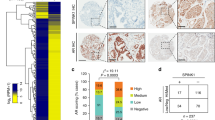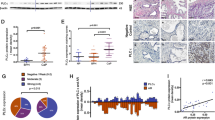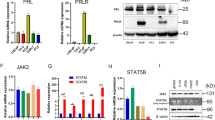Abstract
The expression and secretion of prostate-specific antigen (PSA) are regulated by androgens in normal prostate secretory epithelial cells. In prostate cancer patients, the serum PSA level is usually elevated and cancer cells are initially responsive to androgens. However, those cancer cells become androgen-independent after androgen ablation therapy. In hormone-refractory cancer patients, even in an androgen-deprived environment, the circulation level of PSA rebounds and is constitutively elevated through a yet unknown mechanism. Tyrosine phosphorylation of ErbB-2 is involved in regulating the androgen-responsive phenotype of prostate cancer cells, and it is at least partly regulated by the cellular form of prostatic acid phosphatase (PAcP), a prostate-unique protein tyrosine phosphatase. We investigated the ErbB-2 signal pathway in androgen-independent PSA secretion. LNCaP C-81 cells, which are androgen-independent LNCaP cells lacking endogenous PAcP expression with a hypertyrosine phosphorylated ErbB-2, secreted a higher level of PSA in conditioned media than did androgen-sensitive LNCaP C-33 parental cells. A restored expression of cellular PAcP in C-81 cells was concurrent with a decrease in tyrophosphorylation of ErbB-2 and reduction of PSA secretion. Moreover, transient transfection of C-33 cells with the wild-type ErbB-2 or a constitutively active mutant of MEK1 cDNA resulted in an increased level of secreted PSA. The elevation of secreted PSA level by the forced expression of ErbB-2 was inhibited by an MEK inhibitor, PD98059. In C-81 cells, the expression of a dominant negative mutant of ErbB-2 reduced the secreted level of PSA. The inhibition of ErbB-2 or mitogen-activated protein (MAP) kinases by specific inhibitors AG879, AG825, or PD98059 led to a decrease in PSA secretion. Taken together, our data clearly indicate that the ErbB-2 signal pathway via MAP kinases (ERK1/2) is involved in regulating the secretion of PSA by androgen-independent human prostate cancer LNCaP C-81 cells in an androgen-depleted environment.
This is a preview of subscription content, access via your institution
Access options
Subscribe to this journal
Receive 50 print issues and online access
$259.00 per year
only $5.18 per issue
Buy this article
- Purchase on Springer Link
- Instant access to full article PDF
Prices may be subject to local taxes which are calculated during checkout









Similar content being viewed by others
Abbreviations
- PAcP:
-
prostatic acid phosphatase
- PSA:
-
prostate-specific antigen
- FBS:
-
fetal bovine serum
- EGF:
-
epidermal growth factor
- EGFR:
-
epidermal growth factor receptor
- Ab:
-
antibody
- ECL:
-
enhanced chemiluminescence
- AR:
-
androgen receptor
- IgG:
-
immunoglobulin G
- HA:
-
hemagglutinin
- MEK:
-
MAP kinase/ERK kinase
- ERK:
-
extracellular signal-regulated kinase
- MAP kinases:
-
microtubule-associated protein kinases or mitogen-activated protein kinases
- p-Tyr:
-
phosphotyrosine
References
Auclerc G, Antoine EC, Cajfinger F, Brunet-Pommeyrol A, Agazia C and Khayat D . (2000). Oncologist, 5, 36–44.
Bargmann CI, Hung MC and Weinberg RA . (1986). Cell, 45, 649–657.
Beerli RR, Wels W and Hynes NE . (1994). J. Biol. Chem., 269, 23 631–23 936.
Berchuck A, Kamel A, Whitaker R, Kerns B, Olt G, Kinney R, Soper JT, Dodge R, Clarke-Pearson DL and Marks P . (1990). Cancer Res., 50, 4087–4091.
Bubendorf L, Kononen J, Koivisto P, Schraml P, Moch H, Gasser TC, Willi N, Mihatsch MJ, Sauter G and Kallioniemi OP . (1999). Cancer Res., 59, 803–806.
Chu TM and Lin MF . (1998). J. Clin. Ligand Assay, 21, 24–34.
Craft N, Shostak Y, Carey M and Sawyers CL . (1999). Nat. Med., 5, 280–285.
Culig Z, Hobisch A, Cronauer MV, Radmayr C, Trapman J, Hittmair A, Bartsch G and Klocker H . (1994). Cancer Res., 54, 5474–5478.
Denis LJ and Griffiths K . (2000). Semin. Surg. Oncol., 18, 52–74.
Di Fiore PP, Pierce JH, Kraus MH, Segatto O, King CR and Aaronson, SA . (1987). Science, 237, 178–182.
Gil-Diez de Medina S, Salomon L, Colombel M, Abbou CC, Bellot J, Thiery JP, Radvanyi F, Van der Kwast TH and Chopin DK . (1998). Hum. Pathol., 29, 1005–1012.
Gioeli D, Ficarro SB, Kwiek JJ, Aaronson D, Hancock M, Catling AD, White FM, Christian RE, Settlage RE, Shabanowitz J, Hunt DF and Weber MJ . (2002). J. Biol. Chem., 277, 29 304–29 314.
Gioeli D, Mandell JW, Petroni GR, Frierson Jr HF and Weber MJ . (1999). Cancer Res., 59, 279–284.
Grasso AW, Wen D, Miller CM, Rhim JS, Pretlow TG and Kung HJ . (1997). Oncogene, 15, 2705–2716.
Greenlee RT, Hill-Harmon MB, Murray T and Thun M . (2001). CA Cancer J. Clin., 51, 15–36.
Gu K, Mes-Masson AM, Gauthier J and Saad F . (1996). Cancer Lett., 99, 185–189.
Gullick WJ, Berger MS, Bennett PL, Rothbard JB and Waterfield MD . (1987). Int. J. Cancer, 40, 246–254.
Hobisch A, Eder IE, Putz T, Horninger W, Bartsch G, Klocker H and Culig Z . (1998). Cancer Res., 58, 4640–4645.
Horoszewicz JS, Leong SS, Kawinski E, Karr JP, Rosenthal H, Chu TM, Mirand EA and Murphy GP . (1983). Cancer Res., 43, 1809–1818.
Hung MC, Zhang X, Yan DH, Zhang HZ, He GP, Zhang TQ and Shi DR . (1992). Cancer Lett., 61, 95–103.
Igawa T, Lin FF, Lee MS, Karan D, Batra SK and Lin MF . (2002). Prostate, 50, 222–235.
Johannessen LE, Haugen KE, Ostvold AC, Stang E and Madshus IH . (2001). Biochem. J., 356, 87–96.
Karan D, Schmied BM, Dave BJ, Wittel UA, Lin MF and Batra SK . (2001). Clin. Cancer Res., 7, 3472–3480.
Kimmelman AC, Rodriguez NN and Chan AM . (2002). Mol. Cell. Biol., 22, 5946–5961.
Kuriyama M, Wang MC, Lee CL, Killian CS, Papsidero D, Inaji H, Loor RM, Lin MF, Nishiura T, Slack NH, Murphy GP and Chu TM . (1982). J. Natl. Cancer Inst., 68, 99–105.
Levitzki A and Gazit A . (1995). Science, 267, 1782–1788.
Lichtenstein A, Berenson J, Gera JF, Waldburger K, Martinez-Maza O and Berek JS . (1990). Cancer Res., 50, 7364–7370.
Lin MF, Garcia-Arenas R, Chao YC, Lai MM, Patel PC and Xia XZ . (1993). Arch. Biochem. Biophys., 300, 384–390.
Lin MF, Garcia-Arenas R, Xia XZ, Biela B and Lin FF . (1994). Differentiation, 57, 143–149.
Lin MF, Lee MS, Garcia-Arenas R and Lin FF . (2000). Cell. Biol. Int., 24, 681–689.
Lin MF, Lee MS, Zhou XW, Andressen JC, Meng TC, Johansson SL, West WW, Taylor RJ, Anderson JR and Lin FF . (2001a). J. Urol., 166, 1943–1950.
Lin MF and Meng TC . (1996). Biochem. Biophys. Res. Commun., 226, 206–213.
Lin MF, Meng TC, Rao PS, Chang C, Schonthal AH and Lin FF . (1998). J. Biol. Chem., 273, 5939–5947.
Lin DL, Whitney MC, Yao Z and Keller ET . (2001b). Clin. Cancer Res., 7, 1773–1781.
Loor R, Wang MC, Valenzuela L and Chu TM . (1981). Cancer Lett., 14, 63–69.
Mark HF, Feldman D, Das S, Kye H, Mark S, Sun CL and Samy M . (1999). Exp. Mol. Pathol., 66, 170–178.
Maucher A and von Angerer E . (1993). J. Cancer Res. Clin. Oncol., 119, 669–674.
McCann A, Dervan PA, Johnston PA, Gullick WJ and Carney DN . (1990). Cancer, 65, 88–92.
Meng TC, Lee MS and Lin MF . (2000). Oncogene, 19, 2664–2677.
Meng TC and Lin MF . (1998). J. Biol. Chem., 273, 22 096–22 104.
Myers RB, Srivastava S, Oelschlager DK and Grizzle WE . (1994). J. Natl. Cancer Inst., 86, 1140–1145.
Nazareth LV and Weigel NL . (1996). J. Biol. Chem., 271, 19 900–19 907.
Oesterling JE . (1991). J. Urol., 145, 907–923.
Osman I, Scher HI, Drobnjak M, Verbel D, Morris M, Agus D, Ross JS and Cordon-Cardo C . (2001). Clin. Cancer Res., 7, 2643–2647.
Papsidero LD, Wang MC, Valenzuela LA, Murphy GP and Chu TM . (1980). Cancer Res., 40, 2428–2432.
Pierce JH, Arnstein P, DiMarco E, Artrip J, Kraus MH, Lonardo F, Di Fiore PP and Aaronson SA . (1991). Oncogene, 6, 1189–1194.
Pilat MJ, Kamradt JM and Pienta KJ . (1999). Cancer Metastasis Rev., 17, 373–381.
Press MF, Cordon-Cardo C and Slamon DJ . (1990). Oncogene, 5, 953–962.
Price DT, Rocca GD, Guo C, Ballo MS, Schwinn DA and Luttrell LM . (1999). J. Urol., 162, 1537–1542.
Qian X, Dougall WC, Hellman ME and Greene MI . (1994). Oncogene, 9, 1507–1514.
Qian X, O'Rourke DM, Fei Z, Zhang HT, Kao CC and Greene MI . (1999). J. Biol. Chem., 274, 574–583.
Qiu Y, Ravi L and Kung HJ . (1998). Nature, 393, 83–85.
Ross JS, Sheehan CE, Hayner-Buchan AM, Ambros RA, Kallakury BV, Kaufman Jr RP, Fisher HA, Rifkin MD and Muraca PJ . (1997). Cancer, 79, 2162–2170.
Sadar MD . (1999). J. Biol. Chem., 274, 7777–7783.
Sadar MD, Hussain M and Bruchovsky N . (1999). Endocr. Relat. Cancer, 6, 487–502.
Samanta A, LeVea CM, Dougall WC, Qian X and Greene MI . (1994). Proc. Natl. Acad. Sci. USA, 91, 1711–1715.
Segatto O, King CR, Pierce JH, Di Fiore PP and Aaronson SA . (1988). Mol. Cell. Biol., 8, 5570–5574.
Sherwood ER, Van Dongen JL, Wood CG, Liao S, Kozlowski JM and Lee C . (1998). Br. J. Cancer, 77, 855–861.
Signoretti S, Montironi R, Manola J, Altimari A, Tam C, Bubley G, Balk S, Thomas G, Kaplan I, Hlatky L, Hahnfeldt P, Kantoff P and Loda M . (2000). Natl. Cancer Inst., 92, 1918–1925.
Slamon DJ, Clark GM, Wong SG, Levin WJ, Ullrich A and McGuire WL . (1987). Science, 235, 177–182.
Slamon DJ, Godolphin W, Jones LA, Holt JA, Wong SG, Keith DE, Levin WJ, Stuart SG, Udove J, Ullrich A and Press MF . (1989). Science, 244, 707–712.
Solin T, Kontturi M, Pohlmann R and Vihko P . (1990). Biochem. Biophys. Acta., 1048, 72–77.
Stenman UH, Leinonen J, Zhang WM and Finne P . (1999). Semin. Cancer Biol., 9, 83–93.
Stern DF, Kamps MP and Cao H . (1988). Mol. Cell. Biol., 8, 3969–3973.
Tzahar E, Waterman H, Chen X, Levkowitz G, Karunagaran D, Lavi S, Ratzkin BJ and Yarden Y . (1996). Mol. Cell. Biol., 16, 5276–5287.
Veldscholte J, Berrevoets CA and Mulder E . (1994). J. Steroid Biochem. Mol. Biol., 49, 341–346.
Wang MC, Papsidero LD, Kuriyama M, Valenzuela LA, Murphy GP and Chu TM . (1981). Prostate, 2, 89–96.
Wen Y, Hu MC, Makino K, Spohn B, Bartholomeusz G, Yan DH and Hung MC . (2000). Cancer Res., 60, 6841–6845.
Yeh S, Lin HK, Kang HY, Thin TH, Lin MF and Chang C . (1999). Proc. Natl. Acad. Sci. USA, 96, 5458–5463.
Young CY, Montgomery BT, Andrews PE, Qui SD, Bilhartz DL and Tindall DJ . (1991). Cancer Res., 51, 3748–3752.
Zegarra-Moro OL, Schmidt LJ, Huang H and Tindall DJ . (2002). Cancer Res., 62, 1008–1013.
Zelivianski S, Comeau D and Lin MF . (1998). Biochem. Biophys. Res. Commun., 245, 108–112.
Zhang XQ, Lee MS, Zelivianski S and Lin MF . (2001). J. Biol. Chem., 276, 2544–2550.
Zhou BP, Hu MC, Miller SA, Yu Z, Xia W, Lin SY and Hung MC . (2000). J. Biol. Chem., 275, 8027–8031.
Acknowledgements
We thank Dr Hsing-Jien Kung at the University of California Davis Cancer Center for the kind gifts of ErbB-2 and EGFR cDNAs, as well as the scFv5R cDNA- and pcDNA-transfected LNCaP cells; Dr Robert E Lewis at the University of Nebraska Medical Center for his gift of an anti-Myc Ab (9E10); Dr Stanislav Zelivianski for his helpful discussion; and Mr Michael Demapan and Ms Jamie S Lin for technical assistance. This study was supported in part by NIH grant CA88184, Nebraska Department of Health and Human Services Eppley Cancer Center LB595, National Kidney Foundation of Nebraska, and a Presidential Fellowship from the University of Nebraska.
Author information
Authors and Affiliations
Corresponding author
Rights and permissions
About this article
Cite this article
Lee, MS., Igawa, T., Yuan, TC. et al. ErbB-2 signaling is involved in regulating PSA secretion in androgen-independent human prostate cancer LNCaP C-81 cells. Oncogene 22, 781–796 (2003). https://doi.org/10.1038/sj.onc.1206066
Received:
Revised:
Accepted:
Published:
Issue Date:
DOI: https://doi.org/10.1038/sj.onc.1206066
Keywords
This article is cited by
-
Persistent androgen receptor addiction in castration-resistant prostate cancer
Journal of Hematology & Oncology (2015)
-
A novel function of HER2/Neu in the activation of G2/M checkpoint in response to γ-irradiation
Oncogene (2015)
-
p66Shc—a longevity redox protein in human prostate cancer progression and metastasis
Cancer and Metastasis Reviews (2010)
-
Regulator of G-protein signaling 2 (RGS2) inhibits androgen-independent activation of androgen receptor in prostate cancer cells
Oncogene (2006)
-
Tyrosine-317 of p52Shc mediates androgen-stimulated proliferation signals in human prostate cancer cells
Oncogene (2004)



